2 Oct 2020 | Argentina, China, Japan, News and features, South Korea
“When old people speak it is not because of the sweetness of words in our mouths; it is because we see something which you do not see.”
– Chinua Achebe, Nigerian novelist
When populist governments rise, or when free speech is threatened, it so often falls to the steely wisdom of older generations to fight for justice.
Every age group has its heroes and, so often, older generations are the champions of the young.
Index has covered a range of groups since its inception in 1972 and elderly protesters have often featured. Here is a look at some of the most significant.
Belarus
Across the country, Belarusians are mass protesting current president Aleksander Lukashenko after elections in August appeared to be rigged.
At the forefront of the ongoing protests is 73-year-old Nina Bahinskaya.
The former geologist has certainly become identifiable with the demonstrations. Index’s Mark Frary spoke to her.
“I decided they [the authorities] would not be so harsh to an old lady, that’s why I decided to organise some activities myself,” said Nina.
Bahinskaya began her protesting after the Chernobyl disaster in 1986, distributing leaflets critical of the Soviet regime, so has experience demonstrating against oppressive governments.
“I don’t want it to continue because I have children, grandchildren and even a great-grandchild.”
President Lukashenko recently met with Vladimir Putin. In a showing of support, Putin agreed to give the Lukashenko government a sizeable loan. It has furthered concern in the country about the increase of Russian influence.
Bahinskaya echoed this worry, she said: “This is quite obvious that some kind of new annexation is happening.”
See Index’s most recent coverage and Bahinskaya’s interview with Mark Frary here.
Argentina
In 1976 the National Reorganization Process seized control of Argentina. The military junta were responsible for a number of atrocities. Backed by the United States as part of a ‘dirty war’, the Argentinian government committed acts of state terrorism upon its own citizens, including the forced disappearances of close to 30,000 people.
A higher value was placed upon young children and babies due to a waiting list for trafficked children. Those hopeful of adopting the trafficked children were military families and supporters of the new regime.
Lucia He spoke to one of Argentina’s ‘famous grandmothers’ for Index in 2017. Buscarita Roa, part of Grandmothers of the Plaza de Mayo, has campaigned since 1977 for disappeared victims to be identified.
She told Index: “Even if you’ve found your own grandchild, you stay because you think of the grandmother who is sick in bed and still hasn’t found hers. To us, the grandchildren we are searching for are all ours.”
The group began protesting at the height of the fear spread by the junta. One of the two founding members of the organisation was disappeared. Its high profile led to infiltration. In 1986, an extract from the book Mothers and Shadows by Marta Traba was published in Index. It spoke of the ‘notorious’ Captain Alfredo Astiz, whose access to the group led to 13 further disappearances.
Despite its reputation, Roa insisted there was little glory in being part of the organisation.
“Being a Grandmother of Plaza de Mayo is not something to be proud of, because having a disappeared grandchild is not something to be proud of.”
Japan
In 2018, Annemarie Luck covered one of Japan’s forgotten scandals: the South Korean ‘comfort women’ or, more accurately, sex slaves.
It took until 1992 for survivors to tell their story
Luck reported that some members of the survivors’ group still meet at the same spot every Wednesday outside the Japanese embassy in Seoul.
They were first issued with a signed apology in 1994 by then Prime Minister Tomiichi Murayama and in 2015, an agreement was reached between Japan and South Korea for the equivalent of $9 million.
Victims, as well as South Korean state officials, viewed the agreement as inadequate and protests have since continued.
239 women had registered with the South Korean government by 2016 as survivors of sexual slavery.
The House of Sharing in the city of Gwanju is home to many of the survivors. Team leader at the facility, Ho-Cheol Jeong, told Index of the impact the women he calls the ‘grandmothers’ have had.
Ho-Cheol said: “In a way, these women could be thought of as the original pioneers of the movement against sexual abuse and harassment that’s spreading throughout the world right now.”
Ukraine & Russia
In 2014, Index reported on the Russian government covering up its own soldiers’ deaths from the conflict in eastern Ukraine. Bereaved families were ‘discouraged’ from talking to media organisations.
Since the conflict broke out in February 2014, an estimated 5,665 soldiers have been killed
73-year-old activist and grandmother Lyudmila Bogatenkova faced a retributive accusation of fraud in response to drawing up a list of military casualties.
Bogatenkova was at the time head of a Soldiers’ Mothers branch in the city of Stavropol. The organisation provides legal advice to soldiers, as well as education programmes.
The allegation threatened Bogatenkova with up to six years in jail, before Russia’s human rights council intervened.
At the time, the BBC reported that local journalists were unable to meet the families of perished soldiers due to threats from ‘groups of aggressive men’.
China
Not all grannies are equally ready to stand up in the face of repression.
In 2013, after Chinese media frequently drew attention to stories of neglected pensioners, a new law was introduced.
The legislation stipulates that adults can face jail time or be sued if they do not visit their parents regularly.
Though brought in to Chinese law, it faced derision from across China and the globe and was not expected to be widely enforced. Many believed it was introduced to serve as an ‘educational message’.
However shortly after it was introduced a 77-year-old woman sued her daughter, who was subsequently ordered to provide financial support as well as bi-monthly visits.
The country struggles with the problem of an ageing population that, as numbers continue to reduce could cause economic growth in the region to fall.
12 Mar 2014 | Awards, News and features, Turkey
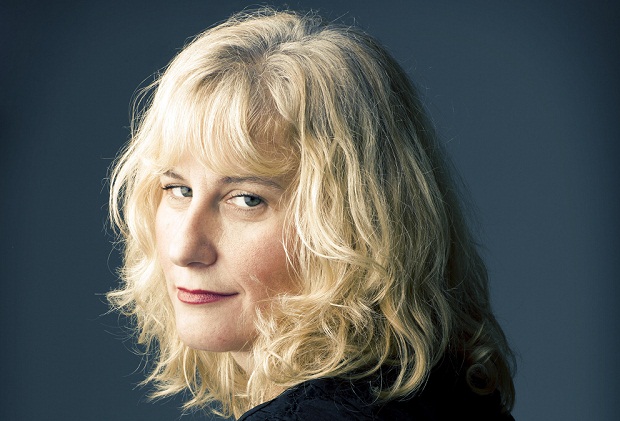
Turkey’s Gezi Park protests of 2013 saw a venting of frustration by many against what they saw as the increasingly authoritarian rule of Prime Minister Recep Tayyip Erdogan’s AK party.
The protests were preceded by the run of Meltem Arikan’s play ‘Mi Minor’ in Istanbul from December 2012 to April 2013. Mi Minor used role play and social media to tell the story of a pianist using technology and social media to struggle against the regime in a fictional land called Pimina. In the month after the play ended, protests erupted in Istanbul, with social media playing a key role.
Arikan, already a prominent writer, found herself accused of fomenting rebellion and faced a co-ordinated campaign of abuse online from government supporters. She recently told Index on Censorship:
“When I was researching for Mi Minor [in 2011] I did everything I could so that the play wasn’t associated with Turkey, or the particular situation of Turkish politics, or any other actual country. It was a fictional dystopia. Mi Minor is an absurd play and it is too worrying to see how absurdity can be accused of being responsible for the reality of what happened in Gezi Park.”
“And the most worrying thing is that these accusations are still on-going. I wrote an absurd play and now my life has become more absurd than my play.”
Forced to flee because of the resulting pressures, Meltem Arikan now lives in the United Kingdom. She spoke with Index on Censorship about her nomination and the future of her work.
17 Feb 2014 | Americas, Brazil, News and features
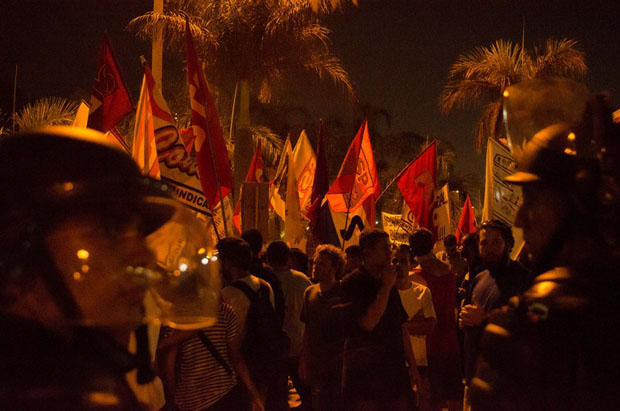
Protests against increase in public transportation costs in Rio de Janeiro on 13 February (Image: Mauricio Fidalgo/Demotix)
On Friday 14 February, Brazil’s Minister of Justice, José Eduardo Cardozo, announced a bill to regulate safety measures during protests. The bill allows for use of force by the military police and punishment for violent actions during demonstrations, and will be sent to congress for consideration in the coming days. The move comes after the death of Bandeirantes Network cameraman Santiago Andrade on 10 February, from injuries sustained covering a protest. This is the latest move by Brazil’s government to control popular discontent ahead of this summer’s FIFA World Cup.
The government is rushing vaguely worded, extraordinary bills defining “terrorism” to the floor of congress. Currently, there are no specific laws for the crime of terrorism in Brazilian legislation. Crimes are classified in the National Security Act, created during the military dictatorship. A number of bills tackling this issue, which could potentially penalise protest actions, are now being debated in congress, without input from the population.
A street protest against rising bus fares in Rio de Janeiro on 6 February erupted in violence, when gas bombs and fireworks thrown by some demonstrators injured seven people, including Santiago Andrade. The cameraman was hit by a rocket firework launched by two protesters, which burst over his head. He later died from the injuries, and the two protesters were arrested in controversial circumstances.
The incident generated national uproar. Congressmen called the protest an act of terrorism and promised action. A number of figures within the Brazilian government, including President Dilma Rousseff, condemned the “escalating violence in protests”. Citing public security, congress moved quickly to table bills aimed at defining actions in public places — both violent and non-violent — as terrorism. Bill 499/2013, which has been fast tracked for consideration, defines terrorism as “causing terror or widespread panic” and threatens penalties of up to 30 years. The bill further stipulates that acts of terror committed with explosives increases the penalty by one third. It also criminalises “Black Bloc” protest groups, and wearing masks. Legal experts have criticised the bill for its vague language which leaves room for wide interpretations. Further, critics contend that it shows the government’s intent to use the bill as a tool to suppress popular protests during the World Cup.
The controversial Bill 728/2011 was created to punish “infractions” committed during the World Cup. In its text, acts of terrorism are associated with religious or ideological positions, and it also limits Brazilians’ ability to strike. The bill was nicknamed the AI-5 Cup, after the 1968 AI-5 act, which in gave extraordinary powers to the then-president and suspended key civil and constitutional guarantees for over 20 years. Under pressure from Brazil’s civil society, 728 was shelved.
Still under consideration in congress, however, is Bill 236/2012 — an anti-terror project that promises to modernise Brazil’s penal code, which dates from 1940. While it categorises terrorism, 236 does not define it. Among its most dangerous threats to freedom of expression is the criminalisation of disturbing the peace, and damage to public property by “vandals” and “vagrants”. The bill does not further define or clarify these terms.
Former justice minister Miguel Reale Jr, a renowned jurist and professor of law at the University of Sao Paulo, criticised the law’s “legal nonsense” and labelled it a setback for journalism. The bill would criminalise defamation and impose four year sentences without adequately defining this offence. He has launched a campaign against it, which has gained support from the legal community.
Bill 236 also contains “crimes against sporting and cultural events”. Any person who promotes “tumult” within 5 km of a sporting event would be imprisoned for up to two years, and the bill would also block protest access to the sport or cultural venue for up to three years. If applied, any popular protest on game days could be banned.
But whether or not some or all of the bills are passed, President Rousseff looks set to be able to curtail protests. On 20 December, a manual on the enforcement of law and public order, put together by the Ministry of Defence, entered into force. The manual defines “opponent forces” as persons, groups or organisations that provoke radical and violent actions, and cites the blocking of public streets as a major threat. Under certain conditions, the manual allows the president to give police powers to the armed forces.
Brazilians who wish to take to the streets, could have an interesting spring.
This article was posted on February 17, 2014 at indexoncensorship.org
27 Sep 2013 | Digital Freedom, Middle East and North Africa, News and features, Sudan
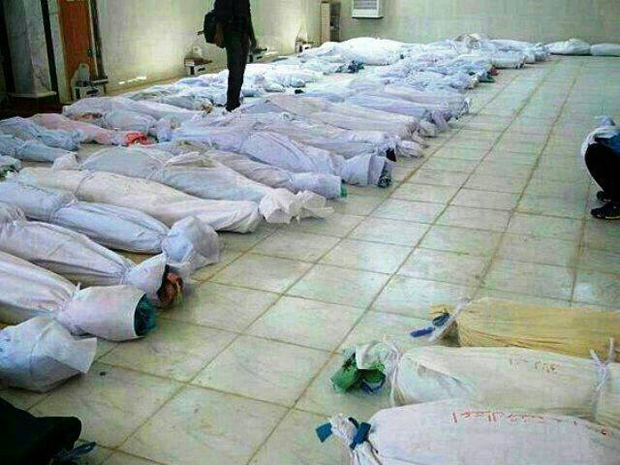
Reports of at least 50 dead have been received from Sudan.
There’s no trying to hide what’s happening within the urban centres of Sudan today. On Wednesday, September 25 at about 1pm, the Sudanese authorities completely shut down the country’s global internet for 24 hours. This happened against the backdrop of spreading peaceful protests following the regime’s decision to lift state subsidies from basic food items and fuel.
In the last few weeks, Sudan’s citizens have been feeling the burden of increasing prices as the Sudanese pound depreciated sharply, and purchasing power declined in a country where 46 percent of the population live in poverty. The lifting of subsidies was met with a popular outburst, especially after a public TV speech by President Omer Al Bashir made it clear that his government has no concrete solutions. He went on to mock the population saying they did not know what hot dogs were before he came to power.
The protests, which started in Wad Madani in Gaziera state, have so far spread to Sudan’s major towns including Nyala in war-struck Darfur. They have been met with unprecedented government violence in the Northern cities of Sudan which have traditionally been peaceful. Live ammunition has been used against protesters, many of whom are school students and youth in their early to mid twenties. By the third day of protests the death toll in Khartoum alone exceeded 100, and 12 in Wad Madani. There have been arrests amongst political leaders, activists and protesters, with more than 80 detainees from Madani alone.
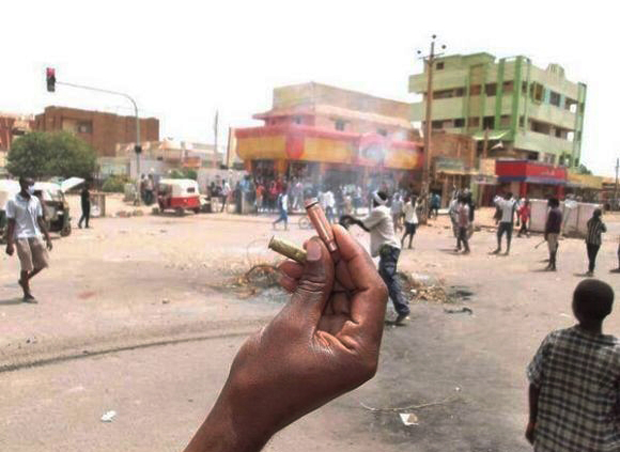
Sudan’s government has cracked down violently, using live ammunition to disperse demonstrators.
Protesters are mainly calling for the regime to step down, with chants of, “liberty, justice, freedom”, “the people want the downfall of the regime”, and “we have come out for the people who stole our sweat”. These protests lack any political or civil society leadership, and so far not a single statement has come from the umbrella of opposition parties, the National Coalition Forces.
Crackdown on the internet and print media
The internet blackout imposed by Sudan’s National Congress Party (NCP) was an intentional ploy aimed at limiting the outflow of information, especially the very graphic images of protesters lying dead in the streets, as well as the images from hospital morgues showing protesters with fatal injuries to the head and upper torso areas. It is clear that this show of force is meant to frighten Sudanese citizens and deter additional protests. (Graphic Images: Street | Street)
This is not the first time the regime in Khartoum has shut down the internet. In June 2013 there was an 8-hour internet blackout during a gathering organized by the Ansar (an off-shoot of the Umma Party) that attracted thousands of people. During the protests last year, dubbed Sudan Revolts, the internet slowed down drastically on the night of June 29, before a large protest was announced.
Since the independence of South Sudan in July 2011, Sudan has also experienced a general clampdown on the media. On September 19, before the start of the protests on Monday, newspapers writing about the economic situation including Alayaam, Al Jareeda and the pro-government Al Intibaha, were confiscated. On Thursday, newspapers including included Al Ayaam and Al Jareeda, refused to print because of the government imposed censorship that prohibits any mention of the ongoing protests. Today Al Sudani and Al Mahjar newspapers (both pro-government) were confiscated, and Al Watan was not allowed to go to press.
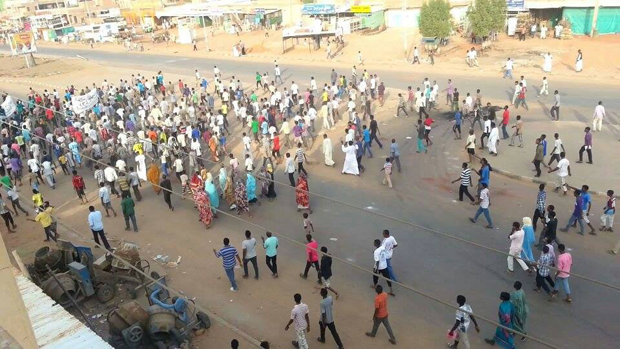
The government of Sudan cut the country off from the internet as protests against the end of fuel subsidies spread.
With most citizens and activists relying completely on social media outlets and internet access through mobile phones to share information, footage and photos, the internet remains the only affordable means to communicate with the outside world. Other options, such as dial-up using modems are not viable for Sudan, as most people have no landlines to connect via modems and depend on mobile devices to access the internet.
During the internet blackout many reported that even SMS messages were blocked. And services such as tweeting via SMS were interrupted by the sole telecommunications provider that carries this service-Zain.
Popular anger and continuing protests
Contrary to the government’s intention the excessive use of force against protesters, the rising death toll and continuing rumours that the internet may be shut down again have not dissuaded citizens, but rather made them more angry and determined, with protests lasting long after midnight in Khartoum. As the streets of the capital and other towns filled up with security agents, riot police and armed government militias, citizens have nonetheless buried their dead in large and angry processions.
Today has been called Martyr’s Friday, in remembrance of all those who have fallen. Protests have been announced in all of Sudan’s towns. In some areas of Khartoum, citizens reported that they were not allowed into mosques for Friday prayers, and that the mosques had a heavy presence of security agents in civilian clothes. This move shows that the regime is anxious protests may follow after the prayers, as well as fearing the possible politicisation of the Friday sermons which may incite more anger.
Nonetheless, this has not deterred more than 2,000 protesters to congregate in Rabta Square, Shambat Barhry (in Khartoum). While writing this, a protester called me to say his internet was not working, and described that even leaders from the communist party, Popular Congress Party and others were starting to arrive. I could hear him with difficulty, but chants in the background were clear, “ya Khartoum, thouri, thouri”—Khartoum, revolt, revolt.
So far one thing is clear: these protests are not a replay of last year’s summer protests that were mainly triggered by university students and youth movements. These are street-supported protests–something that previous protests lacked and a game changer for the NCP who is gradually losing its grip on power.
This article was originally posted on 27 Sept 2013 at indexoncensorship.org
This article was edited on 5 November 2013 at 13:50. The article originally stated that the internet blackout took place on Wednesday 26 September. It took place on 25 September.





